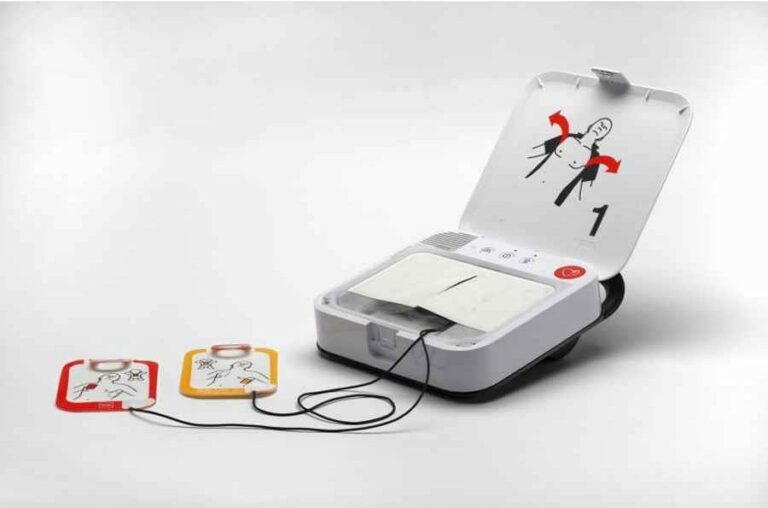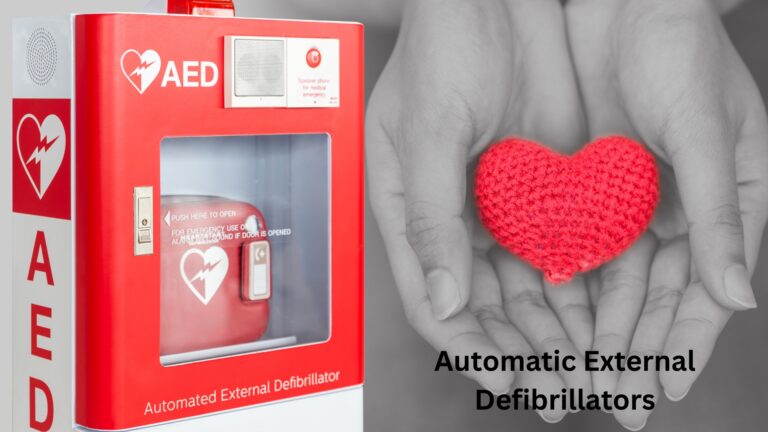September 29th is World Heart Day, making it a great time to explore one of the most important life-saving devices in cardiac care: the defibrillator. With sudden cardiac arrest (SCA) being a leading cause of death for Australians aged 50 and under, defibrillators have become indispensable in public spaces, workplaces, and even homes.
The History of Defibrillators
The concept of using electricity to treat heart problems goes back to the 19th century, but the modern defibrillator as we know it today has a more recent history. Early defibs were large, heavy machines that required open-heart surgery to apply paddles directly to the heart. Over the years, the devices have become smaller, lighter, and easier to use. Here are key milestones in the device’s history:
- 1899: Jean-Louis Prevost and Frederic Batelli discovered that small electrical shocks could induce ventricular fibrillation in dogs, while large shocks could reverse it.
- 1930s: Dr. William Bennett Kouwenhoven and his colleagues developed the first closed-chest defibrillator.
- 1947: Dr. Claude Beck performed the first successful human defibrillation during open-heart surgery on a 14-year-old boy.
- 1950s: Paul Zoll developed the first external defibrillator.
- 1960s: Portable defibrillators were introduced, revolutionising out-of-hospital cardiac care.
- 1978: The first Automated External Defibrillator (AED) was patented.
- 2000s: Public access defibrillation programs began to emerge, placing AEDs in public spaces.
Different Types of Defibrillators
There are several types of defibrillators, each with its own features and applications:
- Manual Defibrillators: These defibs are commonly used by healthcare professionals, especially in hospitals and ambulances. They require trained users to read the patients’ heart rhythm and decide on the energy level for the shock. Although it provides maximum control, advanced training is a must to operate it effectively.
- Automatic External Defibrillators (AEDs): AEDs automatically assess the heart’s rhythm and determine if a shock is needed. These devices guide the user through the defibrillation process with voice prompts and visual cues, making them ideal for public spaces, schools, and workplaces.
- Semi-Automatic Defibrillators: Like an AED, a semi-automatic defibrillator automatically assesses the heart’s rhythm but requires the user to press a button to deliver the shock. This gives the user a slight degree of control while still being straightforward enough for untrained individuals to use in emergencies.
- Implanted Defibrillators (ICDs): ICDs are surgically implanted in patients who are at high risk of sudden cardiac arrest. These devices continuously monitor the heart’s rhythm and automatically deliver a shock when it detects life-threatening arrythmias. ICDs are a standard treatment for patients with severe heart conditions, as they provide constant protection without external intervention.
- Wearable Defibrillators: Wearable cardioverter defibrillators (WCDs) are external devices worn by patients at risk of SCA who are not immediate candidates for an ICD. Worn around the torso, these defibs monitor heart rhythms and deliver a shock if needed. WCDs are often used as temporary solutions while patients wait for further treatment or surgery.
- Other Defibrillator Types: Some specialised defibs are designed for unique environments such as those used in high-voltage workplaces or on military bases. These units may have enhanced durability or functionality suited to specific use cases. AEDs with child mode or paediatric pads are also available for use on younger patients.

Parts of a Defibrillator
While defibrillators vary by type, most share common components that ensure proper functionality:
- Electrodes/Paddles: Electrodes are the sticky pads are placed on the patient’s chest to deliver the electrical shock and monitor the heart’s rhythm.
- Battery: A defibrillator’s power source, usually a long-life lithium battery, is critical for delivering the electrical charge.
- Capacitor: The capacitor stores the electrical charge before delivering it to the heart.
- Control System: This component includes the algorithms and technology that analyse the heart’s rhythm and determine whether a shock is necessary (for AEDs and semi-automatic defibrillators).
- Display Screen: Many defibrillators have screens or indicators to provide real-time information on the patient’s condition and guide the user through the defibrillation process.
- Voice Prompts: Most AEDs feature voice instructions that tell the user exactly what to do, making the process as simple as possible in high-stress situations.
- Data Storage: Keeps records of event data for later review.
How a Defibrillator Works
Defibrillators work by delivering a controlled electric shock to the heart to restore its normal rhythm.
In the case of an AED, the process typically follows these steps:
- Power on the device: Most AEDs turn on automatically when the case is opened, but some may require a button to be pressed. The device charges its capacitor to store the necessary energy.
- Apply the pads: The electrodes are placed on the patient’s bare chest in specific positions.
- Analyse the heart rhythm: The AED automatically checks the heart’s electrical activity to determine if a shock is necessary.
- Deliver the shock: If needed, the device instructs the user to stand clear and press a button to deliver the shock. Some fully automatic AEDs will deliver the shock without user intervention. This shock momentarily stops the heart’s electrical activity and allows its natural pacemaker to potentially re-establish a normal rhythm.
- Post-shock monitoring: The AED continues to monitor the heart and provides instructions on performing CPR if necessary.
Common Misconceptions About Defibrillators
Several myths and misconceptions surround defibrillator use, which can lead to hesitancy in emergencies. Let’s debunk some of the most common ones:
- Myth 1: Defibrillators can restart a stopped heart: Defibs are designed to correct abnormal heart rhythms, not to restart a heart that has completely stopped. In cardiac arrest cases, CPR is needed to maintain circulation while defibrillation attempts to restore a functional rhythm.
- Myth 2: Only trained professionals can use defibrillators: AEDs are designed for anyone to use, with clear voice instructions and automatic rhythm analysis. While training is beneficial, it’s not a requirement to use an AED as they are designed to be user-friendly with clear voice prompts.
- Myth 3: You can harm someone by using a defibrillator incorrectly: AEDs are designed to be safe. They will only deliver a shock if the heart’s rhythm indicates it is necessary. It’s far better to attempt to use a defibrillator in an emergency than to do nothing.
Defibrillators: When to Use and How
Knowing when and how to use a defibrillator can mean the difference between life and death.
When to Use:
- The person is unresponsive and not breathing normally.
- You suspect sudden cardiac arrest.
How to Use:
- Call emergency services.
- Start CPR immediately.
- Send someone to fetch the nearest AED.
- Turn on the AED and follow its voice prompts.
- Remove any clothing from the person’s chest.
- Attach the electrode pads to the bare chest.
- Allow the AED to analyse the heart rhythm.
- If a shock is advised, ensure no one is touching the person and wait for the shock to be delivered.
- Resume CPR immediately after the shock, or if no shock is advised.
- Continue this cycle until emergency services arrive.
Australian Legislation for Workplace Defibrillators
While there is no national legislation mandating defibrillators in Australian workplaces, some states have specific requirements.
Queensland requires AEDs in certain high-risk workplaces like amusement parks and aquatic centres. Western Australia and South Australia recommends AEDs in workplaces with over 100 workers or where there’s a high risk of cardiac arrest. By January 1, 2025 certain buildings, facilities and vehicles across South Australia, including all those owned by the Crown must have AEDs.
In New South Wales, Victoria, Tasmania, and Australian Capital Territory, organisations such as WorkCover and WorkSafe encourage AED installation, with Northern Territory recommending it especially in high-risk workplaces.
Despite the lack of uniform legislation, many Australian businesses are voluntarily installing AEDs as part of their workplace health and safety strategies.
Other Interesting Facts About Defibrillators
- Survival Rates: For every minute without defibrillation, the chance of survival decreases by 10%.
- Public Access: Many countries are implementing public access defibrillation programs, placing AEDs in locations like airports, shopping centres, and sports facilities.
- Smartphone Integration: Some newer AEDs can connect to smartphones to call emergency services automatically and provide real-time CPR feedback.
- Drones: Some areas are experimenting with drone-delivered AEDs to reach cardiac arrest victims faster.
- Water-Resistant Models: Special AEDs are designed for use in wet environments like pools or beaches.
- Maintenance: While AEDs require minimal maintenance, regular checks are crucial to ensure they’re ready when needed.
- Cost-Effectiveness: Studies have shown that public access defibrillation programs are cost-effective in terms of lives saved.
- Training: While AEDs are designed for use by untrained individuals, regular training can improve confidence and effectiveness in an emergency.
- Global Impact: The World Health Organisation estimates that widespread access to defibrillators could save 100,000 lives annually worldwide.
- Future Developments: Research is ongoing into wearable defibrillators and implantable devices that can predict cardiac events before they occur.
Defibrillators have come a long way since their inception, evolving from large, complex machines to user-friendly devices that can be found in many public spaces. As we approach World Heart Day, it’s crucial to recognise the life-saving potential of these devices and the importance of public awareness and access.
While legislation varies across Australia, the trend is moving towards greater availability of defibrillators in workplaces and public spaces. Understanding how these devices work, when to use them, and dispelling common myths can empower more people to act confidently in a cardiac emergency.
Remember, in the event of a suspected cardiac arrest, quick action is crucial. Call emergency services, start CPR, and use an AED if available. These simple steps, combined with the power of defibrillation, can significantly increase the chances of survival.
As technology continues to advance, we can expect to see even more innovations in defibrillator design and accessibility. However, the most important factor remains human readiness to act. By educating ourselves and others about defibrillators, we can all play a part in creating heart-safe communities.

